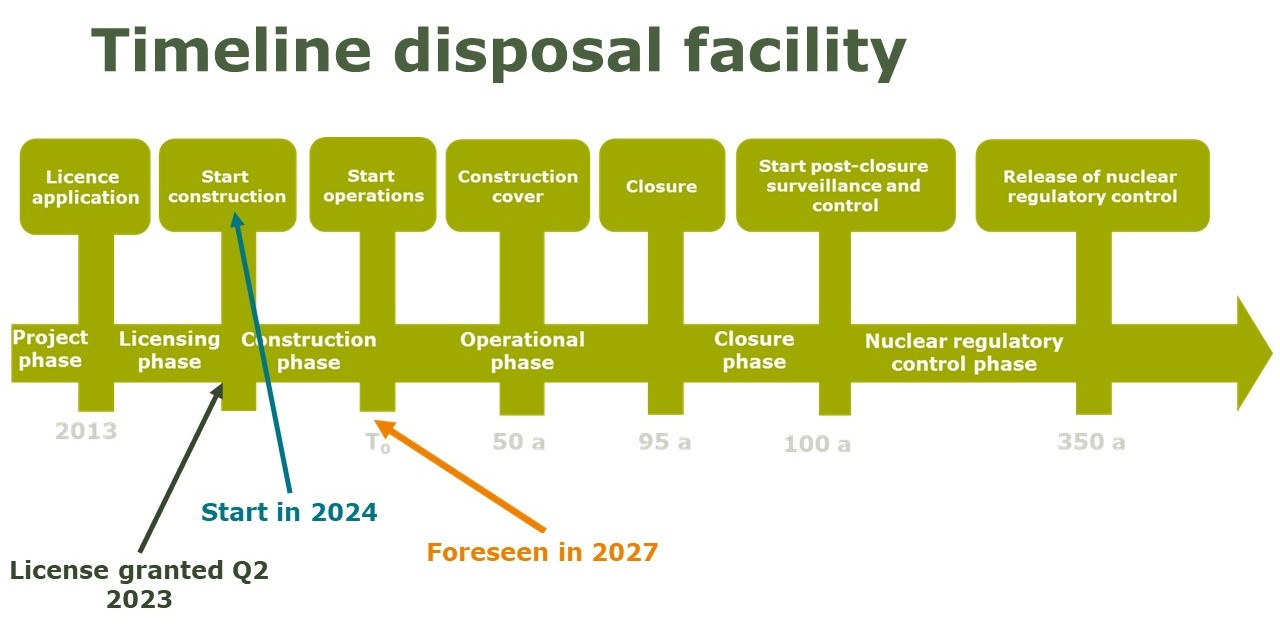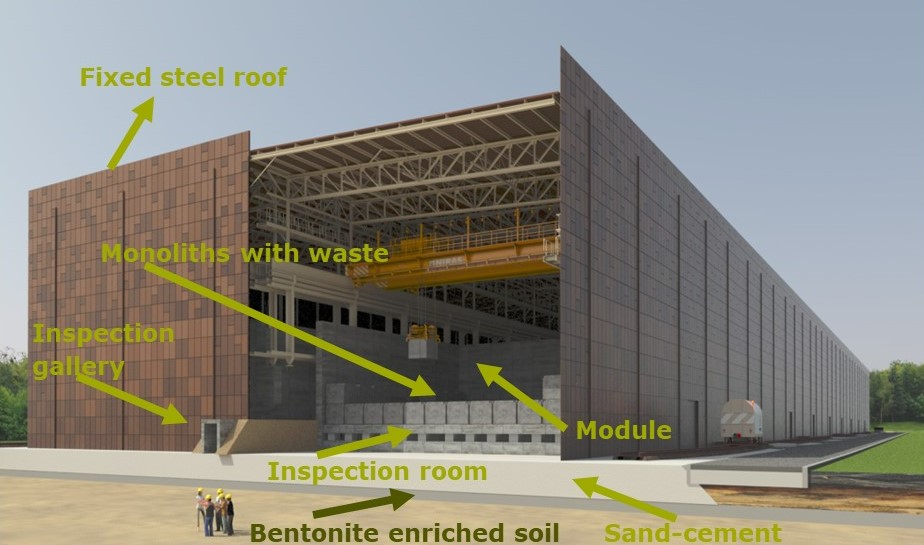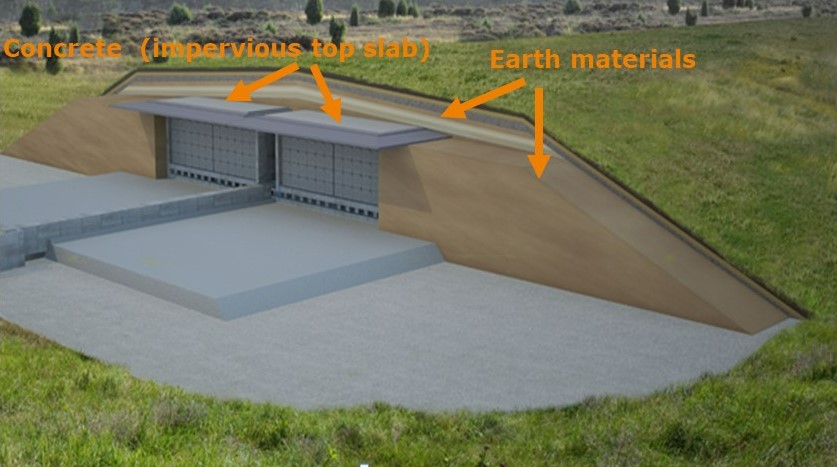License granted for a near surface disposal facility in Belgium
Introduction of cAt-project
NIRAS/ONDRAF, the Belgian National Agency for Radioactive Waste and Fissile Materials, was granted a license for the construction and exploitation of a Near-Surface Disposal facility for disposal of low and intermediate level short lived radioactive waste. The repository will be build in Dessel right next to Belgoprocess site. Belgoprocess is responsible for the safe processing of radioactive waste produced in Belgium, which cannot be handled by the producer, and for temporary storage of this waste.
The construction of the repository will start in 2024 and NIRAS/ONDRAF aims to start operations in 2027.

Objective and design of the facility
During the first part of the operational phase of the repository (see Figure 1), the waste to be disposed of will be presented in the form of monoliths (disposal packages); these are concrete caissons filled with waste (either drums or bulk waste) and immobilized with a filling mortar. The monoliths will be disposed of in concrete modules (vaults), which are equipped with a fixed steel roof with a bridge crane. The total 34 modules will be divided into an eastern zone consisting of 20 modules (2 rows of 10 modules) and a western zone consisting of 14 modules (2 rows of 7 modules). After filling and sealing, the modules will be covered with a multi-layer cover (based on engineered earth materials, e.g. compacted clay) to create two tumuli (second part of the operational phase, which starts 50 years after operation has begun. Underneath the multi-layer cover an impervious top slab, made out of fiber-reinforced concrete, is placed. This is the main barrier to limit water infiltration into the disposal facility.


After a monitoring period, during which certain parts of the facility (inspection room and inspection gallery) are still accessible, the installations will be closed and a Nuclear Regulatory Control Phase will start, during which supervision and monitoring of and around the tumuli will continue. After this Nuclear Regulatory Control Phase, the facility can be released from further nuclear control and will lose its status as a nuclear facility. For the moment this release is foreseen 350 years after the start of the operation.
Longterm safety concept and safety assessment
The main role of a repository on the long term is to contain (actions aimed at preventing and limiting the release of radionuclides) and isolate (separating waste and humans in space and time, including in case of (accidental) human intrusion) the radioactive waste.
In function of the evolution of activity/radiotoxicity of the radioactive waste, the containment strategy of the repository system consists of preventing the release of radionuclides for 1,000 years and then limiting the release of radionuclides from the repository system.
To fulfill this strategy, ONDRAF/NIRAS invokes, on the one hand, limiting water infiltration to the waste and, on the other hand, limiting the release of radionuclides from the disposal system.
The phenomenologically expected evolution of the tumuli is largely determined by the multilayer cover and impervious top slab. Indeed, these are designed to prevent any seepage of water for at least 1,000 years. The presence of the cover further also imposes buried conditions on the underlying components, which will bring carbonation, which is the main degradation process of the underlying concrete barriers, almost to a halt. Another crucial assumption made by ONDRAF/NIRAS is that the modules cannot degrade from within as a result of physicochemical processes of which the degradation of the waste form is the initial cause. In order to realize this, ONDRAF/NIRAS has imposed strict chemical and physical conformity criteria on the monoliths and the waste contained therein.
As a result, the physical integrity of the modules and monoliths is expected to be maintained for ~1000 years. Thus, no active corrosion of the reinforcement and formation of a network of continuous cracks is expected. Consequently, during this period, the transport of radionuclides in the monoliths would be predominantly diffusion-dominated in line with the safety concept briefly explained above.
From ~1000 years, it is expected that due to degradation of the cover (erosion, earthquakes) the impermeable top slab, module walls, and monoliths would be locally exposed to atmospheric conditions, as a result of which carbonation and freeze/thaw cycles could gradually lead to local degradation of these concrete components. From this point on, throughgoing cracks throughout the disposal system are no longer ruled out. These networks of cracks would form preferential pathways through which radionuclides could leach more rapidly out of the monolith. Transport in the disposal system would be expected to be advection-dominated, with the exception of low permeability concrete matrices in which radionuclides were already present before 1000 years. Diffusion-dominated transport is expected in the those components. This is once again in line with the safety concept, as after 1,000 years, the release of radionuclides from the repository system is limited.
In the following step, the phenomenologically expected evolution is translated into an expected evolution scenario (EES). This means that for the EES the hypotheses are chosen in line with the expected evolution and the parameters are the Best Estimate values. After a sensitivity and uncertainty analysis based on the EES the reference scenario (RS) is determined. The RS is defined such that its estimated maximum impact is enveloping the estimated impacts of the EES and thus considers all computational cases in the uncertainty analysis (e.g the lower bound values instead of the best estimate values for the distribution coefficients of the different radionuclides). Based on the RS, the radiological impact is calculated and compared with the dose constraint of 0.1 mSv/a, which is respected.
In addition to the scenarios of expected evolution, possible disruptions to expected evolution are also considered. Here, ONDRAF/NIRAS considers the following types of scenarios:
- Alternative Evolution Scenarios (AES): Scenarios that are representative and enveloping of not expected but possible evolutions of the disposal system (e.g. accelerated erosion of the cover or a beyond design earthquake);
- Human intrusion Scenarios: Scenarios enveloping inadvertent human intrusion that would occur in the disposal after it was relieved of nuclear regulatory control. These are therefore scenarios used to determine the isolation properties of the disposal system.
A final type of scenario considered for long-term safety assessment is the penalizing scenario (PS). The PS is intended to present the evolution of the disposal system in a enveloping manner when performance can no longer be reliably estimated. The starting point of this PS is chosen by ONDRAF/NIRAS at ~2000 years.
Tom Van de Velde
Bel V
tom.vandevelde@belv.be